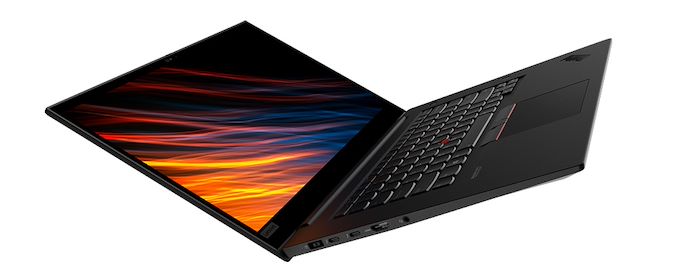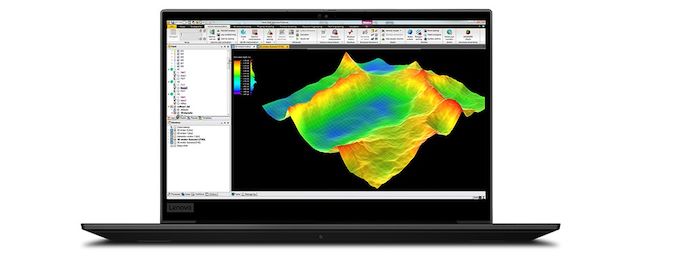Lenovo’s New ThinkPad P1 Gen3 for Professionals: OLED, 8-core Xeon, Quadro
by Dr. Ian Cutress on June 17, 2020 9:30 AM EST_678x452.jpg)
At the high-end of Lenovo’s ThinkPad designs, where professionals need server-grade features like ECC and graphics focused on compute or rendering, we get the P1 model which is updated for 2020 as the P1 Gen3. This notebook refresh is a 15.6-inch design, offering an OLED display, choice of Intel 10th Gen or Xeon processors, and Quadro-level graphics. The underlying design of the chassis is carbon fiber, aiming to be sturdy yet lightweight, with a fingerprint resistant finish to enhance the aesthetic of a premium system.
The ThinkPad P1 Gen3 is a 15.6-inch design with options that include a 3840x2160 OLED touch display at HDR500, a 3840x2160 LCD IPS variant up to 600 nits, or a 1920x1080 IPS 500nit HDR lower-cost option. Under the hood it supports Intel’s 10th Gen Core mobile 45 W processors, or their Xeon equivalents, which extends support to up to 64 GB of ECC for the Xeons via two SoDIMM slots. Graphics are available up to an NVIDIA Quadro T2000. There are two M.2 drives in the system, allowing for up to 4 TB of NVMe SSDs in RAID 0/1, and the system comes with an 80 Wh battery. Two power supplies are available – a base 135 W slim model or a 170 W slim model. Operating system options include Windows 10 Home, Pro, Pro for Workstations, Ubuntu, Red Hat (certified), or Fedora.
For professional users, the P1 Gen3 supports TPM, has a touch fingerprint reader for easy log-in, and a shutter mechanism for the 720p webcam. There is also an optional separate Hybrid IR camera. On the connectivity side, Intel’s AX201 Wi-Fi 6 solution is included as standard, but a CAT16 LTE smartphone modem is an optional extra, which comes in the M.2 form factor. The system is certified for a number of software vendors, such as AutoCAD, CATRIA, NX, SolidWorks, Revit, Creo, Inventor, etc.
From the design, the unit comes with the usual ThinkPad bells and whistles. The keyboard includes the TrackPoint in the middle of the keyboard, and the track pad at the bottom has physical keys above it. The keyboard is backlit and spill resistant. Ports on the side include two USB 3.2 Gen 1 Type-A ports, two USB-C Thunderbolt 3 ports, a HDMI 2.0 video output, a 3.5mm jack, and an SD Card Reader.
The P1 Gen3 comes with Lenovo’s ThinkShield software, and will also be the recipient of Lenovo’s new Ultra Performance Mode that allows the user to adjust the performance settings in order to achieve a desired performance or thermal characteristics of the system. Lenovo believes this is mostly relevant to users who need full turbo to get a project completed on time, or for those who use the system with VR and require a minimum standard of performance without any potential thermal disruptions.
The P1 Gen3 starting weight is 3.75 lbs (1.7 kg), which will add on with the addition of a graphics card / more memory / more storage etc. The Lenovo ThinkPad P1 Gen3 will be available from July, starting at $2019.





_carousel_thumb.jpg)
_carousel_thumb.jpg)
_carousel_thumb.jpg)
_thumb.jpg)








59 Comments
View All Comments
Evil Underlord - Wednesday, June 17, 2020 - link
All this time, and Lenovo still hasn't shifted back to a better screen ratio. If it weren't for their keyboards, I'd have been gone long ago.mmrezaie - Wednesday, June 17, 2020 - link
Every couple of years I switch between Mac and Thinkpad but this new charger (not a USB-C), and speaker are just too many compromises to get that keyboard, this time. I may actually look into Dell vs Apple this time.drkrieger - Wednesday, June 17, 2020 - link
Sadly, adding the dedicated video card pushes most power delivery outside of the USB-C spec. Anything north of 90W will likely require a non-standard power connection to deliver the needed amperage.Valantar - Wednesday, June 17, 2020 - link
Dell uses "sort of custom" (i.e. not in the official spec, but still fully supports the standard) 130W type-C chargers, why can't others do the same?quiksilvr - Wednesday, June 17, 2020 - link
The wattage of the charger is 130W to provide consistent 100W charging to the laptop. It's overhead. The USB-C spec is still limited to 100W.karatekid430 - Thursday, June 18, 2020 - link
I believe it is actually 130W. Just because the USB-IF has placed an artificial limit, does not mean they cannot exceed it. If the charger advertises a 20V 6.5A profile on top of the standard 20V 5.0A standard profile, and the laptop is programmed to accept that, then it will work. The charger will be using a captive cable so that you cannot use a standard USB-C to USB-C cable which might not be good for the additional power. Dell must have checked the USB-C receptacles and plugs which they use and determined them to be safe for 6.5A.I am hoping the USB-IF will add a 48V 5A mode (240W). 48V is considered to be the upper limit of "safe" low voltage. It happens to be the voltage of phantom power used to power condenser microphones.
s.yu - Thursday, June 18, 2020 - link
I've always wondered why it's called phantom power...PeachNCream - Saturday, June 20, 2020 - link
Its infested with ghosts and others of that ilk.yasamoka - Friday, June 19, 2020 - link
They deliver power out of spec. They did that since the Dell XPS 15 9550 with their USB-C dock. It's capable of delivering 130W to the laptop. The CPU's TDP is 45W and the GPU's TDP is 90W, so the laptop can and will draw more than 100W given thermal constraints do not throttle it down to below that.WinterCharm - Thursday, June 18, 2020 - link
This is why Apple went through all the trouble of HBM on a 5600M -- getting that power to 50W was tricky.